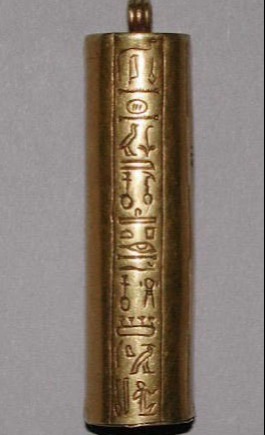
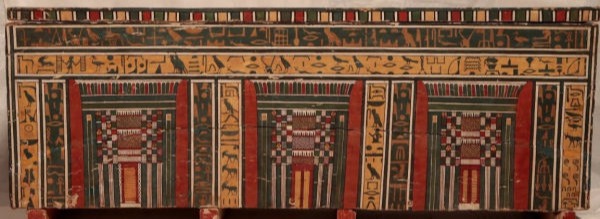
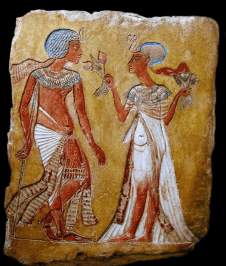
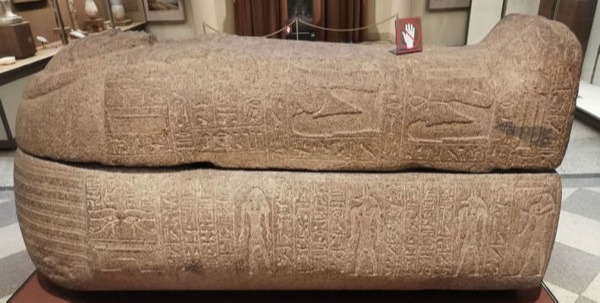
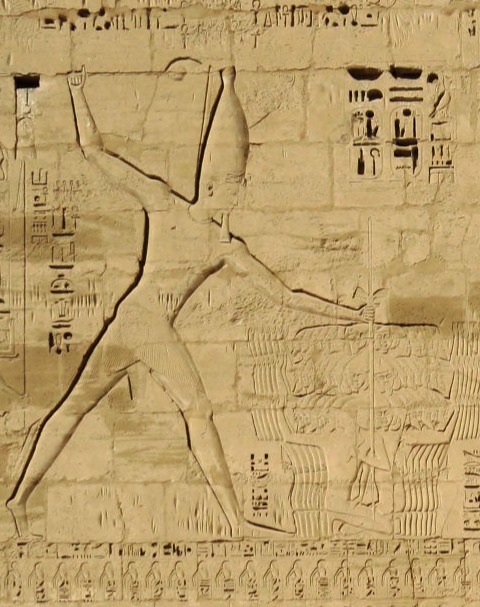
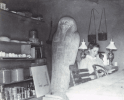
2021






On the 3rd of May 1941 a bomb landed on the roof of the Central Library, next to the museum. Thousands of objects were destroyed or damaged. Well documented records were available showing what had been lost from the 7000 objects. Large amounts of pottery, ceramics, stelae and sculptures were lost or damaged.
There had been many different donations made to the museum, some from excavations as reward for donations, and some from private collectors like Joseph Mayer(1886/7). About 3000 objects from the Egyptian and Nubian collections had been lost or damaged and damp storage conditions had caused deterioration to some of the remaining objects. Miss Elaine Tankard, the curator, asked many excavators, especially from the Liverpool Institute of Archaeology, for exhibits to fill up the gaps in the collections, especially pottery and ceramics.
Between 1942 and 1980 a huge effort was made to rebuild the collection. The government created the war damage scheme and allocated £79000 to help do so. This allowed many collections to be bought.
Douglas Allan, the director at this time, was responsible for acquiring many of these, including that of Miss Amy Urlin, sister-in-law of Flinders Petrie. Born in Rustington, Sussex, into a middle class family, she accompanied her sister, Hilda, and Petrie, a difficult and demanding man when excavating, to Egypt. Conditions were primitive for both workers and family. Petrie was described as ‘ dirty, verminous and odiferous as a polecat’ hardly what a well brought up Englishwoman was used to. Hilda’s journal describes conditions as lacking in comfort but with beautiful sunrises and sunsets. In April 1898 she writes to Amy that Cairo is stuffy and hot, unlike the freedom of the desert where no stockings or underwear were worn because of the heat.
In 1900 the 3 of them return to Egypt overland via Paris, Marseilles, Malta and Alexandria to Cairo, visiting local sites, especially the Pyramids and Giza where it is likely she bought some of the items in her collection. This time, a friend, Beatrice Orme, accompanied them. She also collected (and donated) artifacts, mostly from Hu, Abadiya and Abydos.
Hilda’s journal, in February 1901, describes traveling to Abydos in a litter carried by donkeys and living in a mud brick and straw dig house with grass mats for doors, chests for storage and huge spiders….all about work, not comfort. Outside was a courtyard for processing pottery ready for writing up….Petrie was training up John Garstang at this time. There is a photograph of Amy in the storehouse keeping things tidy and with European style pots and some tinned foodstuff. The 1st Dynasty tomb (2985BC) of Hor-den was being excavated in this area.
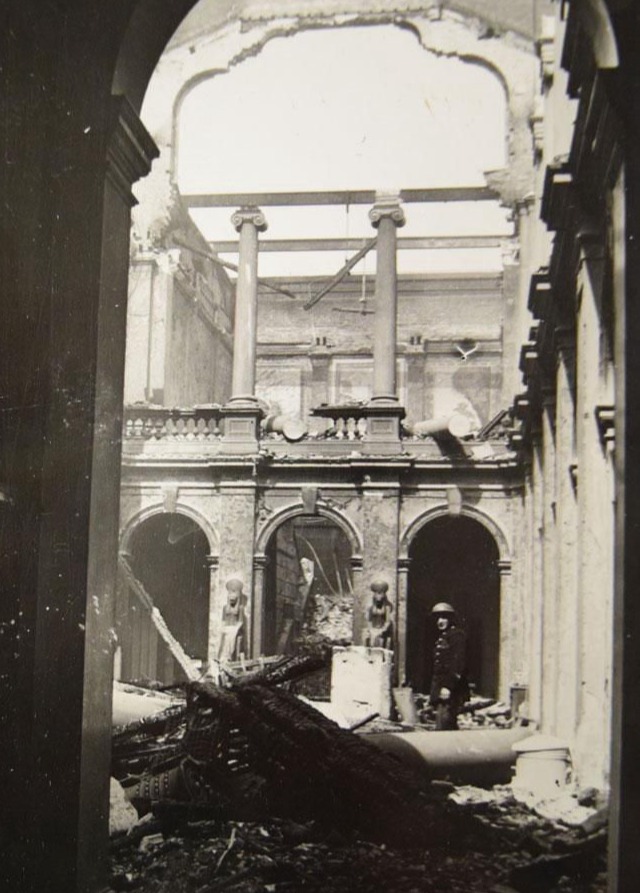
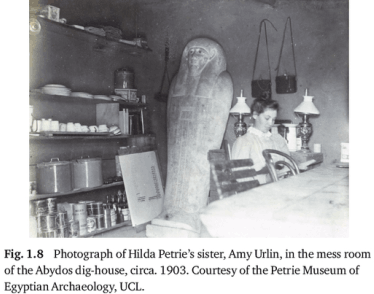
In her letters, Amy describes sorting out fragments of pottery and glueing them together prior to photographing them up and writing up her results. Miss Orme processed the photographs, published under the title ‘ Royal Tombs of the Earliest Dynasty’ in 1901. Amy and Beatrice’s work was described by Petrie in the forward.
At this time, Hilda describes Amy as using indelible ink to mark pieces of pottery. Hundreds of fragments had been found and excavated, but then discarded by earlier excavations in spoil heaps. Alice Stevenson points out that Amy’s work in this field has been invaluable as these dig marks link up objects in different museums…….’an object whose value was credited through the development of new sets of relationships between dig sites, instructions and individuals’ i.e. her marking established links between pieces sent/given to different collections, now in different museums/private collections.
Amy received in payment, artifacts distributed by the Egyptian Government….explaining to some extent how parts of the same objects ended up in the hand of different people. She also bought objects from locals…photographs show her buying objects at Abydos from 3 local boys. 3 vases can be identified from these photographs as being in her collection. She also acquired shabtis from the Ramesseum, either as a gift, by purchase or through sponsorship……another method by which objects could be obtained. A letter from Hilda describes collecting offering cups from king Men-Ka-Ra as there were many scattered around the complex.
In late life Amy was actively involved in the Egyptian Research Students Association. In 1912 she lends part of her collection to the Kensington Art Gallery and dies in London in 1932
Her collection in Liverpool consists of 461 pieces with objects spanning across 5000 years from predyanstic to Roman/ Ptolemaic.
32% is jewellery, mostly small items. There are 1421 items, mainly beads, strung or single. In 1944 they were accidentally mixed up with another collection, so some lost their tags. During lockdown work was done to research via the records to find provenance for these items. Most are made of faience, semi-precious stones, even eggshells. Some have been restrung. There are 28 ear ornaments, either rings or plugs including an unusual ear stretching plug, 44mm wide from a burial at Esna. Also there are 7 finger rings.
27% of the collection is amulets, some used in everyday life, some found in burials. The most common is the Eye of Horus followed by those of Bes.
7% is items used in grooming and for cosmetics. There are 34 items, mostly jars, combs, hairpins and tweezers. Most unusual are an eye makeup pot from the New Kingdom (1500BC) shaped like Taweret, and another one shaped like a monkey. Both are small…about 50mm high.
4% is shabtis, 20 of which are from Amy’s collection and are about 92 mm tall.
The President closed his lecture by thanking us for inviting him to speak.

11th November 2021
Jo started her lecture by explaining that for us to be able to grasp the context of magic in Ancient Egypt, we need to make a total mind-shift away from current ideas surrounding magic which include awkward relationships with the occult and trickery by stage performers.
Indeed the actual word, magic, has nothing to do with Egypt and can be traced backwards through Middle English, Old French, Latin, Ancient Greek and Old Persian to its roots in proto Indo-European. In Ancient Egypt the word we now translate as magic was heka, which was also the name of one of the gods. There were no magical people, no-one was born with magic, this was something which was acquired through learning and wisdom and it was never used as entertainment. Although we use the word magician, in Ancient Egyptian the term actually means master of secrets. The Ancient Egyptians saw heka as a weapon to protect them against danger by night and by day and, through omens and predictions, as a power; it was an effective tool in the constant battle for maintaining order and keeping chaos at bay.
Medicinal knowledge in Ancient Egypt was thorough and advanced, but it appears that magic and medicine were fused. Each treatment was more often than not made up of both a rational medical component and a magical one, with the latter being spoken aloud to invoke ritual power. The written spells have a pattern to the text, which strongly suggests a chanting rhythm; this is something to be vocalised. Sometimes, if no effective physical remedy was available, magic became the whole treatment. It was considered very effective for warding off harmful spirits which could manifest as demons and the vengeful dead and also protected against dangerous creatures such as scorpions, snakes, lions, spiders and, rather surprisingly to us, gazelles.
In Predynastic times, as there are no written records, there is little evidence of magic, other than that suggested by amulets. In the Old Kingdom a little more can be identified, again through amulets, but also from the Pyramid Texts and scenes showing the use of magic in some tombs, such as those of Mereruka and Ti at Saqqara. More evidence is seen in the Middle Kingdom with texts and objects mentioning the practice of magic. Two finds in particular, both excavated by Petrie, provided a wealth of objects. At the Ramesseum a 12th Dynasty tomb shaft was found in the area of the magazines with a wooden box inside, now known as the Magician’s Box. It contained 23 fragmentary papyri (of which 21 were magical), ivory wands, pens, a bronze uraeus entangled in hair, amulets and figurines including a herdsman carrying a calf and an individual holding snakes. A similar find was also found at Kahun, where a box was uncovered close to a dwelling labelled by the team as the house of the magician. It was suggested that this was the magician’s kit which he took round with him to perform his magic.
Extensive evidence is available from the New Kingdom in many forms and we also have the Dream Book in which numerous dreams are given an interpretation followed by an indication of whether the outcome will be good or bad. Later Periods also provide a wealth of material and we see the development of the Horus Cippus with Horus the Child standing on the back of a crocodile and holding lions, snakes or gazelles, demonstrating his power over them. Gods are generally shown in the background and spells inscribed on the back and base. The Metternich Stelae have very similar imagery but also a basin below. Wine or beer could be poured over the figure and the liquid would be drunk after the magic had been drawn into it, so even those who could not read the spells could benefit from the power of the magic.
The line between magic and religion is hard to define and as the Ancient Egyptians had no word for religion, it may be that they saw them as fused and not separate entities. All magicians were priests, though not all priests were magicians and in the temples there was no cult of magic or specific worship of magic. Several of the gods, however, were associated with magic (Isis, Heka, Horus and Thoth) and this was an aspect that the Ancient Egyptians seemed to turn to in situations which they were unable to deal with themselves. There is also evidence of magic at a local level and in Deir el Medina we are aware of a scorpion charmer, a doctor who used medical texts and a wise woman.
Finally Jo considered the question of curses. Opinion is divided over the use of magic for this purpose. A figure found with nails pierced through the eyes, ears and mouth was taken as such, but an alternate theory proposed that this was a love spell, with love entering at these points. The difficulty is that some words have alternative meanings and different interpretations are possible.
There is no doubt at all though, that to the Ancient Egyptians heka was very real and very dangerous and only to be practised by those with the necessary knowledge. The Harris Magical Papyrus instructs the magicians to keep their magic secret and amongst the priestly caste only – it was not for others. The tale of The Book of Thoth gives a strong warning to the prince determined to search for it that he should be extremely wary of seeking it for himself as no good will result. He refuses to heed the warning and, after finally finding the legendary book, disaster ensues.
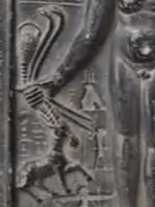
11th October 2021
Dr. Landborg began by giving us the background to the coffin texts from the end of the 5th Dynasty through the 1st Intermediate Period and explained that they were developed from the pyramid texts. They were initially inscribed on the inside of coffins, where many new spells designed to ensure and ease a safe and successful passage to and through the afterlife, were included. An example is that of Gua from Deir el Bersha, currently in the British Museum (EA 30840). She suggested that these spells could be spoken aloud and that ritual actions could be incorporated, perhaps as a drama. She informed us that over 1700 examples of such texts had been found and described by Adriaan de Buck in his book ‘The Egyptian Coffin Texts’.
She explained how the style of coffin decoration had developed over time and pointed out that there was no standard style across the country, each region had its own variations. The main focus of her research has been the Assiut area. She illustrated the development with two coffins in particular : 11th Dynasty, Tjeby, now in the Virginia Museum of Fine Arts and Khnumhotep, 12th Dynasty, held in the Metropolitan Museum.
These showed the transformation over this period starting with just one band with the offering formula, but then moving to the addition of columns of text and depictions of the Ennead. This final style was the standard followed in the main part on the coffins of the Two Brothers, held in the Manchester Museum. She explained that coffins also included a depiction of a false door and an offering list, placed on the side of the coffin, as can be seen on the inside of Seni’s outer coffin, now in the British Museum (12th Dynasty).
She then looked at the coffins of the Two Brothers in more detail.
These were excavated by Flinders Petrie intact in 1907 in the Assiut region and dated to the 12th Dynasty on stylistic grounds. They were inscribed to say that they both had the same birth mother. Margaret Murray and Rosalie David have produced books containing full translations of the texts found on the coffins. A curious aspect of the coffin text spells is that on the coffin itself they are frequently found to be just an extract. In some instances they start, but then just stop abruptly as the available space runs out, whilst others have large chunks missed out so that they will fit. In one case the written text is so truncated that the actual purpose of the spell is omitted. They end up as snippets only, rather than the full spell being recorded on the coffin, in a similar manner to the vignettes in Books of the Dead.
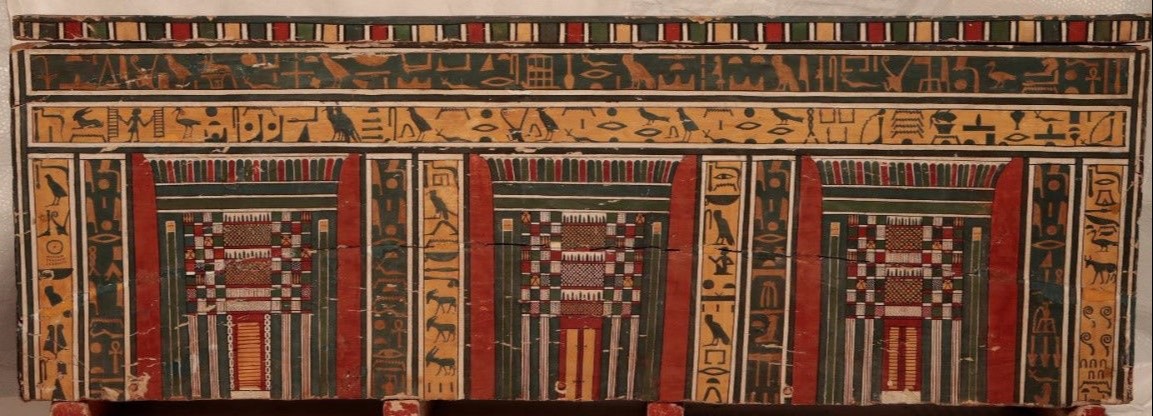
Nakht-Ankh’s coffin contains the offering formula plus spell 220 from the pyramid texts and part of spell 61 from the coffin texts. Here we see signs that these were amended by the scribe rather than just being copied as he appears to run out of space and has had to shorten and squeeze in his extract. Only a section of each complete spell is used, the possibility being that this was considered a representation of the whole spell and enough to make it effective. In some cases spells 220 and 221 are drawn together as one text, showing how little of the complete spell is used.
Khnum-Nakht’s coffin shows the same. Spell 30 ends in the middle of a sentence, which makes the meaning seem very obscure, but again this suggests that not all the spell is needed for it to take full effect. Spell 30 and 31 are used together in a set sequence to transform the dead into a righteous person to enable them to reach the afterlife, but again we see editing by the scribe rather than just copying.
It would appear that each scribe used different ways to chose what they included…..either
1. Cramming words into the available space.
2. Sacrificing sense…just stopping when available space is used up.
In what appears to be the local tradition in Assiut long offering formulae were found on the coffins, many gods were named and sometimes scenes of workers working were shown, for example on the coffins of Wepwawet and Nakht. Many coffins from this area contain extracts from spells 30 to 37 and 38 to 41 for different parts of the body. These are more detailed and extensive but are still not depicted as complete spells. Some are really truncated…just a short phrase. Usually all 4 sides, the lid and base were covered in segments from spells.
Spells 32 to 37 have been looked at and, with the detail being on the outside of the coffins, this suggests that perhaps they were used, in some part, as a drama-dialogue that could be recited or acted out by a single priest or by a group during an offering ceremony or at a festival, or as part of the funeral ritual to ensure safe passage through the underworld to the afterlife. So, it seems that only a short snippet from each spell could be adequate rather than the whole spell, which in any case would not fit into the available space.
In conclusion, Dr. Landborg described that the coffins of the Two Brothers were decorated outside and inside using sections of spells which represented whole spells or whole spell sequences and despite the fact that they were incomplete, they would still be just as effective. No coffins have examples of all the coffin texts and it is unclear how the spells to be used in each particular case were chosen. Their purpose was to ease the way into the afterlife and the false door and food offering on the coffins ensured the dead had their needs supplied even if relatives didn’t visit.
Altogether a lecture full of thought provoking ideas. Thank you Dr. Landborg.
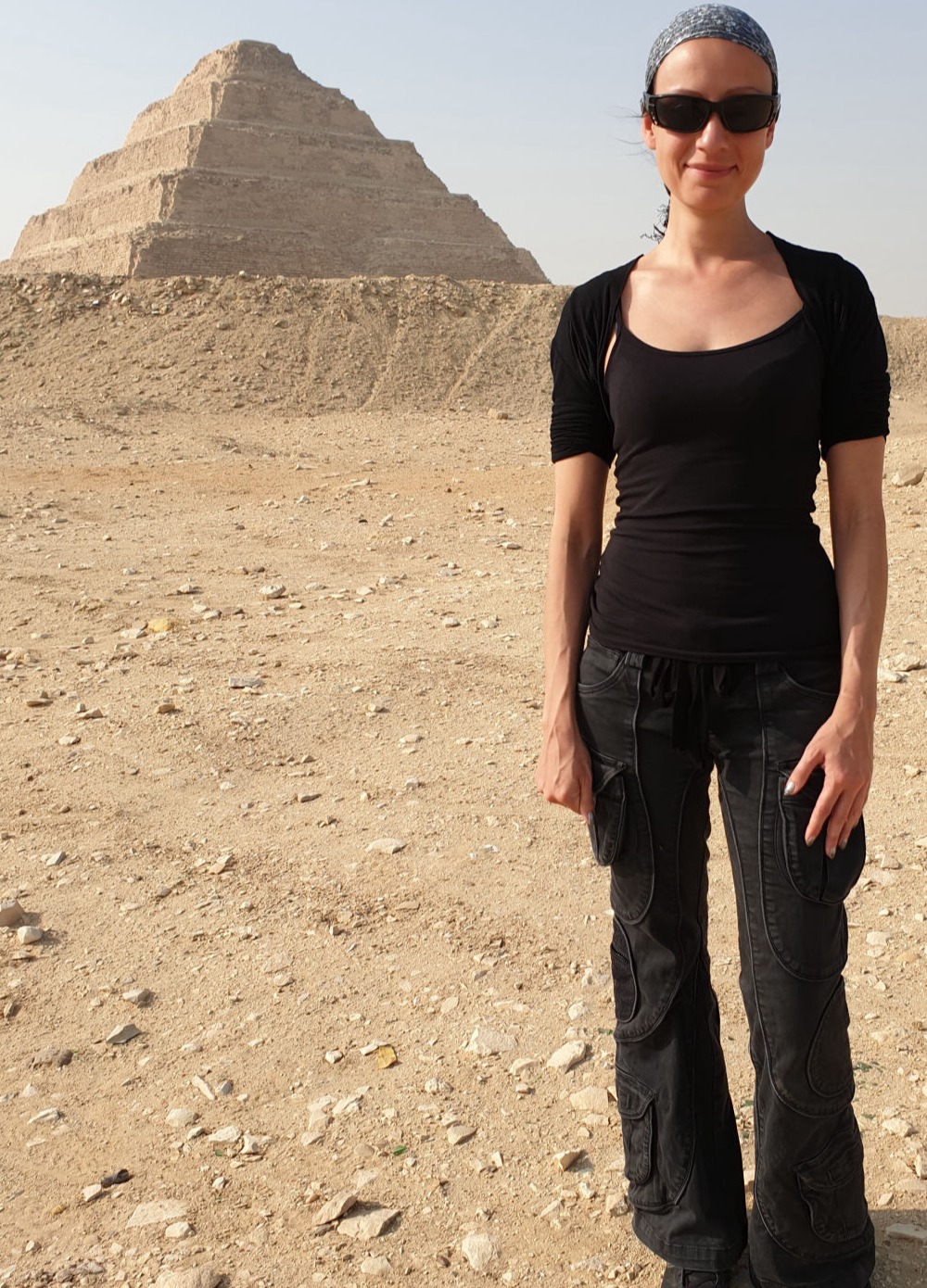
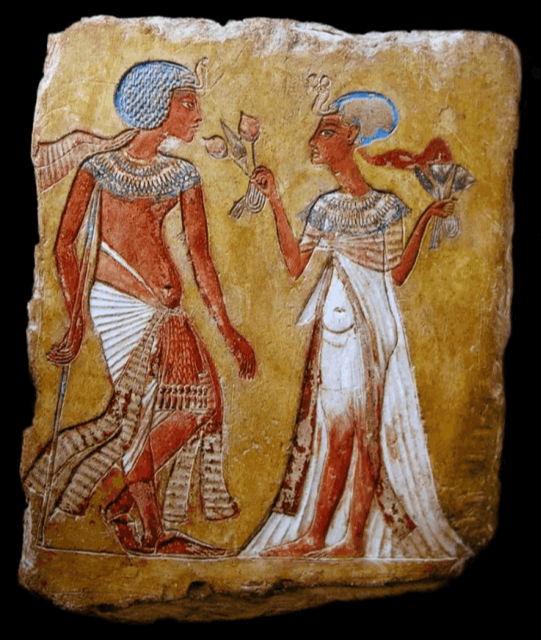
13th Sept 2021
Huub started by looking at a relief, probably from Tel el Amarna, of Semenkhkara, who ruled for about a year before Tutankhamen, and his wife….or possibly of Tutankhamen and asked 3 questions……
1..who was he?
2..who is buried in tomb KV55?
3..where is his tomb?
And then he answered them.
1.. who was he?
Huub theorised that he was in fact Akhenaten’s Great Royal Wife, Nefertiti, who had reigned as a co-ruler with him, then on her own under the name of Semenkhkara for about a year, immediately prior to Tutankhamen becoming Pharaoh.
He believes she was a Mitanni princess and quotes Amarna letters negotiating a marriage between Tadukhepa (Nefertiti), the reputedly very beautiful daughter of King Tushratta, sent to Egypt to be the principal wife of Amenhotep and also daughter-in-law to him and Queen Tiye, i.e. wife of Akhenaten and named as co-ruler even before year 5 of his reign. He quotes a name carved in a cartouche on a scarab as evidence. All 6 of Akhenaten and Nefertiti’s daughters are shown with elongated skulls, more common in the area once called Mitanni, now Anatolia. He reminded us that Nefertiti’s name translates as ‘the beautiful one has come’ again a possible way of identifying her as this foreign princess.
During the 15th regnal year Nefertiti is given her throne name and is shown smiting her (Egypt’s) enemies. Was Akhenaten ill and unable to rule on his own? Did he die in his 17th regnal year, after which she changed her name to Semenkhkara and ruled with her daughter Meritaten as Great Royal Wife?
2..who is buried in Tomb KV 55?
On January 6th 1907, the entrance to KV55 was found. Many believe that this was the tomb of Semenkhkara but no artifacts bearing his name have been found.
So, whose is it then?
It’s a small tomb with large fragments of a gilded shrine but the names on this appear to have been removed. 3 mummies were found there. There are a few possible original owners.
1..Queen Tiye
Her carved head shows evidence of co-ruler status, under the false wig similar to the depiction on the gilded shrine fragments. Canopic jars found there show a female face with a Nubian wig similar to Tiye’s.
2..reburial of Akhenaten
Was his body reburied here after Amarna was abandoned? Similar inscriptions have been found on a vase found at Tel el Amarna with the same text used repeatedly. Huub suggests the same coffin was reused for Akhenaten and moved to KV55 with 2 other mummies, possibly Tiye and Kiya.
The golden face will have been scraped off to remove the face as a symbolic destruction of the owner’s name. The badly damaged remains of a man found in KV55 could be Semenkhkara, but Huub believes it is Akhenaten.
3..Kiya
There is evidence that the original inscription containing the texts for Kiya and for concubine were replaced. Her tomb (Tutankhamen’s mother?) has not been identified. Evidence exists in a relief from Amarna of a funeral scene, possibly of Kiya dead after childbirth, with Meritaten holding a baby, probably Tutankhamen.
4..Prince Thutmose; Akhenaten’s older brother who died in adolescence. Was it his tomb originally? The damage on the male mummy’s head in the side chamber of KV35 matches the damage on the coffin found in KV55.
5..Meritaten
Eldest daughter of Akhenaten and Nefertiti who died about year 10 of his reign. Did she become his wife? This was common amongst the royal families. Some of the texts about Kiya show evidence of being altered to read Meritaten.
6..Sitamun
Daughter of Amenhotep III, sister of Akhenaten, possibly married to both? Could she be Tutankhamen’s mother? The text relating to Kiya is similar to that for a concubine or was she just a court lady?
3..where is his tomb?
Huub points out that many of the objects found in KV55 were originally made for a female burial and were reused for Tutankhamen’s interment and inscribed in a similar way to how Nefertiti’s name was written when co-regent i.e. ‘Useful to her husband’. The golden mask itself shows signs of reuse and is renamed for him, not made for him.
In Tutankhamen’s tomb…KV62, opposite KV55, a vase (jar, 405 Met Museum) was found showing a text (removed) which when reconstructed showed evidence of a co-regency of Akhenaten and Semenkhkara and a wooden box, recently restored, shows the throne name of Nefertiti from her 3 years as co-regent with her husband, where both are referred to as Kings of Upper and Lower Egypt, with Meritaten named as Great Royal Wife to both of them.
This, Huub suggests, means the most likely site of Semenkhkara’s tomb is somewhere in the Theban region, most likely in the Valley of the Kings.
So, he concludes by suggesting answers to his 3 questions as follows:
1..Who was Semenkhkara?
Tadukhepa = Nefertiti = Semenkhkara.
2..Who was buried in KV55?
Prince Thutmose, Tiye, Kiya, Sitamun?
If not Prince Thutmose, then Akhenaten…moved there at a later date.
3..Where is the tomb of Semenkhkara?
Valley of the Kings..somewhere, not yet discovered?
KV62?.......behind a painted wall and blocked up
But certainly somewhere within the Theban area.
Thanks to Huub for a fascinating lecture, leaving us with much to think about.
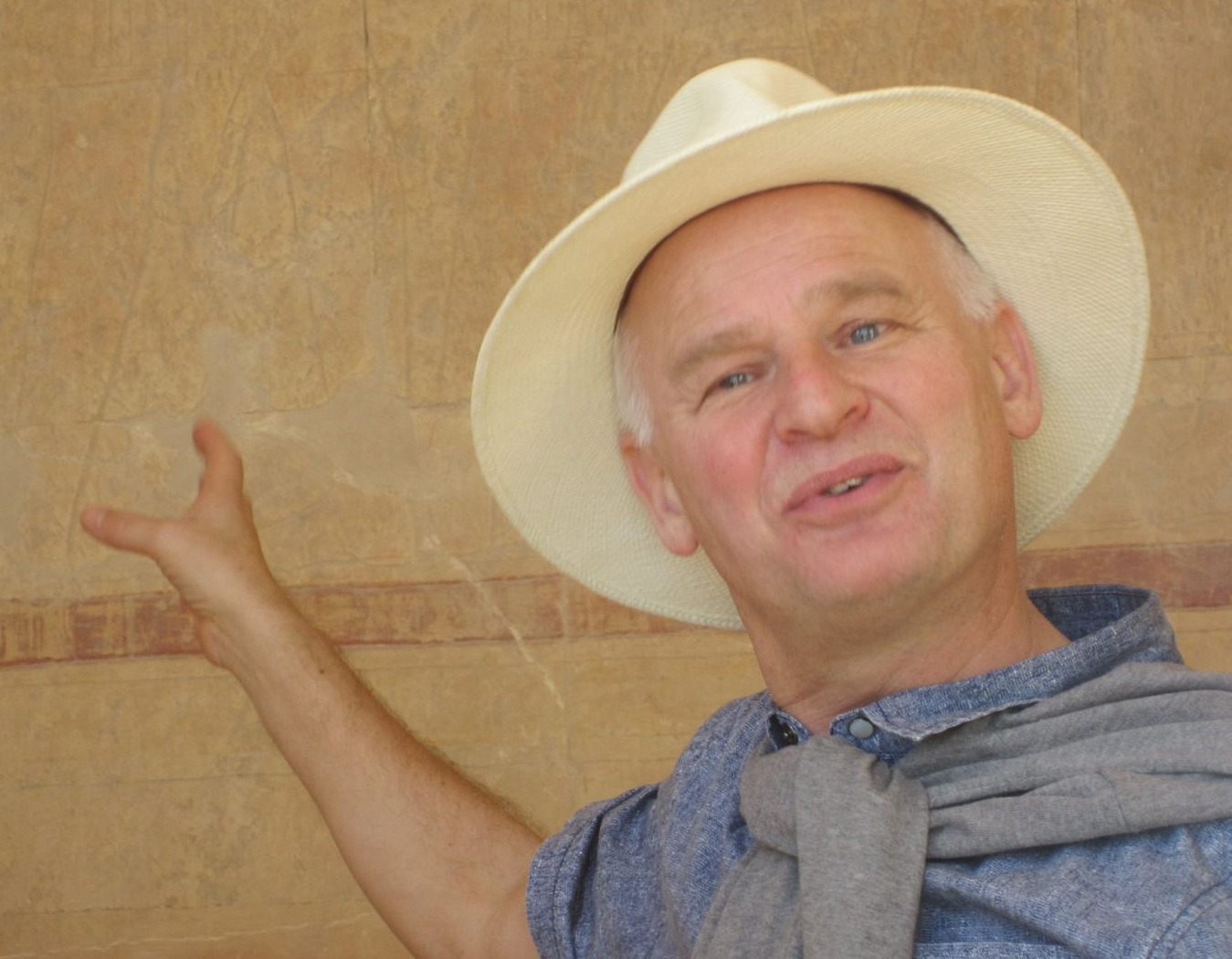
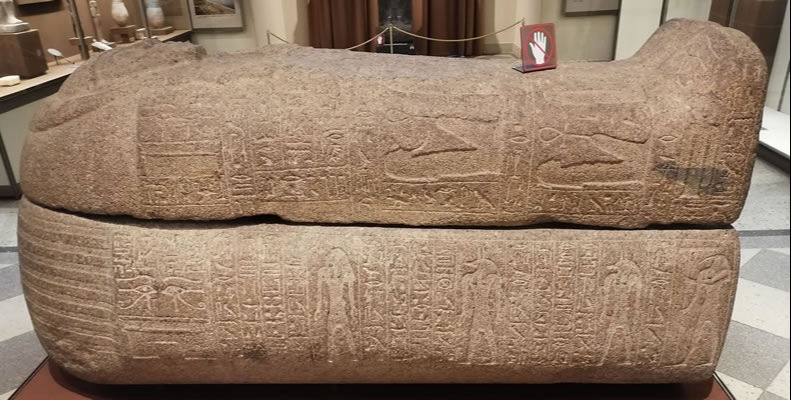
9th August 2021
Wolfram informed us that he previously participated in a project in Berlin to create a database of Ancient Egyptian coffins from all periods of Egypt’s history. His research gave him a detailed insight into the changes in coffin design over time and he outlined for us the styles used by private individuals, as opposed to royalty, from the Old Kingdom through to the end of the Rameside period. The coffins (wooden) and sarcophagi (stone) all belonged to people of high status – important officials, high priests and members of the royal court.
Old Kingdom numbers in the database amounted to 3000, giving a clear picture that at this time the material of choice for containers for bodies was stone and, with a very few exceptions, these were undecorated.
In contrast, most coffins in the Middle Kingdom were constructed from wood, though there were some exceptions amongst those of very high status. Early in the Middle Kingdom a standard form of decoration was used on almost all coffins, including two eyes on the side, and this was found on the outside of the coffin. Later, although this same style was still followed, there was further decoration added to the inside, with text and images on all four sides. Towards the end of this period a somewhat different style was adopted in royal court burials.
Another innovation during the Middle Kingdom was the human-shaped coffin. These were used as the innermost of the coffin set.
The Second Intermediate Period saw the introduction of the Rishi coffin, with its feather pattern. Again this was an anthropoid shape, but at this time it was a stand-alone coffin and not part of a set.
The funerary culture of the New Kingdom had four distinct phases. The first, up until the time of Hatshepsut and Tuthmosis III was notable for the fact that almost all objects accompanying the burial were objects of daily use. Wooden coffins continued to be used, but the Rishi style had been superseded by white coffins, which again were anthropoid. Scenes of humans at the funeral were depicted on the outside. Only one white coffin made of stone (in the BM) is known and must have belonged to an individual of extremely high standing.
In phase II more objects than just those from daily life began to be included and black coffins were introduced. These had greater detail than the white ones and images of deities were also included. Invariably Nut would be found under the lid, Nephthys at the head and Isis at the feet. During the reign of Amenhotep III the increased wealth of the country was reflected in more elaborate decoration on coffins. At this time the Four Sons of Horus started to be included, though at this stage with human heads; they did not assume the well-known animal heads until the Rameside Period. As would be expected, there was a major stylistic shift during the reign of Akhenaten, with the deities being replaced by bearers bringing offerings for the deceased.
Phase III lasted from the time of Tutankhamun to Seti I and during this period the funerary objects included almost no items from daily life, though the addition of many floral bouquets appears to have been a common feature. Yellow coffins were now used and were highly decorated, however the use of stone coffins also increased and the lids began to be fashioned in the shape of the individual dressed as they had been in life. The artwork was of a high standard and some even had facial features inlaid with precious stones.
Daily life objects disappeared completely from the burials during phase IV – from Rameses II to the Third Intermediate Period. Decoration initially became yet more elaborate and the yellow coffin style was now recreated in gold. This phase started as a heyday for stone sarcophagi, which were the choice of most high officials. Those attached to the royal court tended to be buried at Memphis/Saqqara and Thebes, but numerous other officials were buried in the provinces, returning in death to the place of their birth. Granite was commonly used, attesting to the wealth and social level of the individuals and, on these sarcophagi produced at the royal workshops, the lid was a representation of the person, wearing a wig and a broad collar, with crossed hands holding different standardised objects for men and women. By the end of the reign of Rameses II the decline in Egypt was reflected in the standard of craftsmanship in the workshops, with many clumsily worked sarcophagi and texts that were frequently inaccurate. Production then declined quite quickly and more or less stopped in the 20th Dynasty, other than for royal burials.

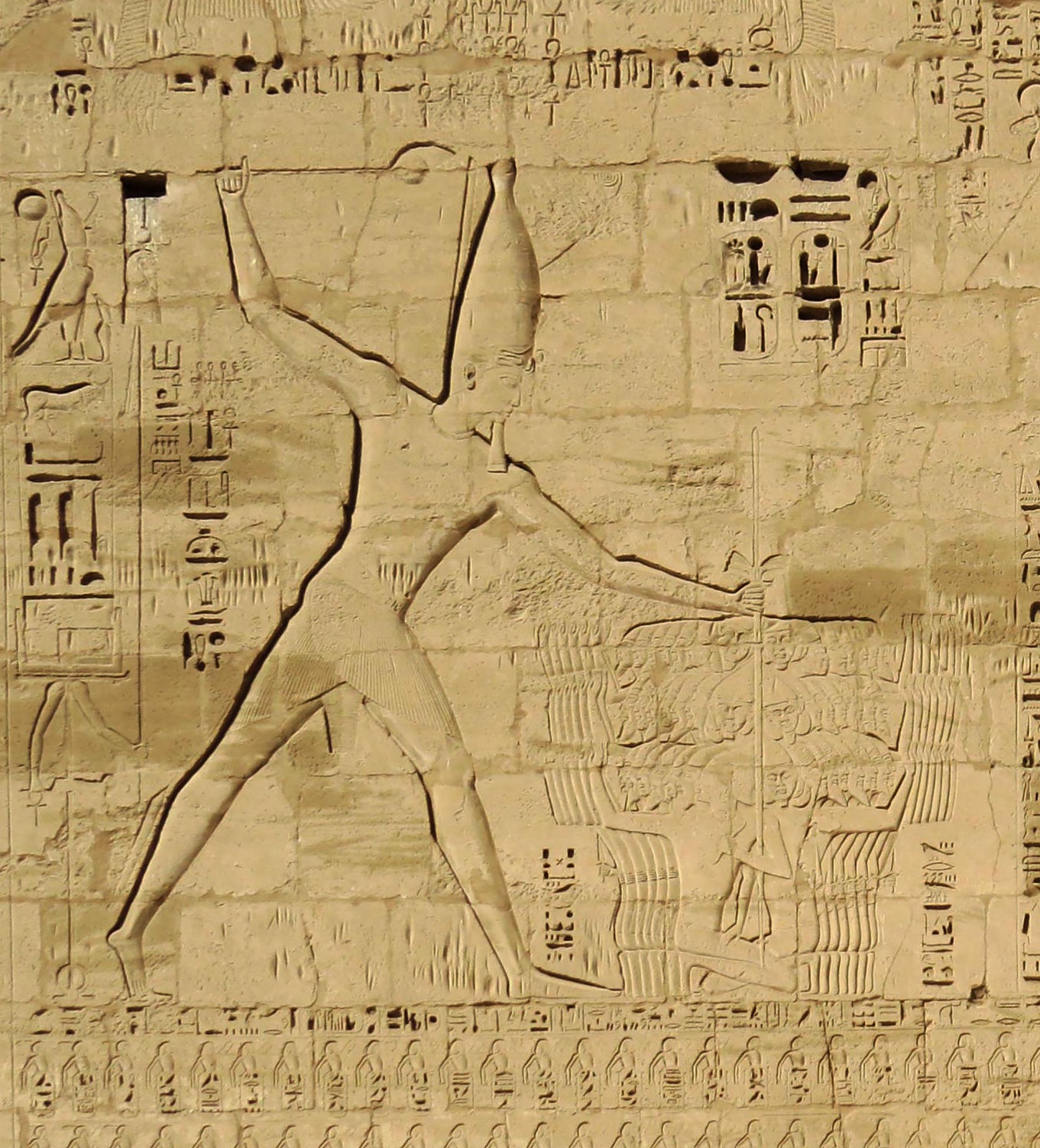
12th July 2021
Aidan delivered an excellent and fascinating lecture to the Society based around his recent publication and giving us an insight into the man, his reign and his fate.
Rameses III came to the throne after the troublesome years following the death of Rameses II, when there had been a succession of short contested reigns with bitter rivalry. A period of strength and stability was needed and the Great Harris Papyrus records much historical information detailing how Rameses III provided this. It is abundantly clear that Rameses III drew his inspiration from his namesake Rameses II.
There was a considerable plan of building works during his reign and structures can be found throughout the length and breadth of Egypt. There is an interesting set of giant cartouches and kingly scenes at Tihna el-Gebel and Gebel Sheikh Harida and more in the Sinai and Northern Arabia, perhaps associated with trade routes. A major programme was undertaken in Thebes with 3 structures wholly attributable to Rameses III. A fourth is mentioned in the Great Harris Papyrus (which lists all of the building works), but to date has not been discovered. There were also many additions by him to existing buildings, such as on the back of pylon VIII at Karnak, where a previous gap was filled in, plus many more at both Karnak and Luxor temples.
A temple was also built at Edfu, though this was built over later in the Ptolemaic period, and a lintel at Buhen, much further south, glorifies a victory by the Viceroy of Nubia in Rameses III’s time.
The most well know of his building works is, of course, Medinet Habu. In design and intent this was a third as large again as Rameses II’s mortuary temple and had palatial living accommodation attached to it, for occupation during festival times. It was surrounded by a massive enclosure wall, which also encompassed the earlier 18th Dynasty temples and had substantial gates on the east and west sides. It was here, in fact, that his life would come to a sudden and dramatic end. The walls of the temple were covered in scenes which celebrated the achievements of the king in his lifetime, with details of campaigns and victories in many far flung places, depicted particularly on the northern wall. In the 1970s there was considerable scepticism about the battles recorded and they were considered to be an idealisation of what a king would wish to have achieved in his reign. However, subsequent research debunked this view and all of the conflicts shown are now believed to have taken place.
Around 1200BC there was a period of unrest and severe decline amongst the powers to the north of Egypt’s borders and a mass movement down towards Rameses III’s territory, which is reflected in the battle scenes. Egypt appears to be the only culture bordering on the Mediterranean basin which did not slide into collapse, though the knock on effect of the social, political and economic decline in the areas around did impact Egypt towards the end of Rameses III’s reign. His rule lasted for 32 years, with a Hebsed Festival in year 30. Usually an event of this nature would have been commemorated in huge scenes in many locations, but very few references have been found, leading scholars to believe that it was a relatively low key event as a result of the degenerating political and economic situation, with a crisis looming and widespread shortages of grain. Further evidence of the unstable situation can be found in the first recorded strike in history by the workers at Deir el-Medina, who had not received their ‘pay’ and refused to work until it arrived. The Turin Strike Papyrus gives a most interesting insight into this unprecedented event.
The make-up of the royal family was also very different to previous reigns, especially in the fact that Rameses III had at least two, if not three great royal wives – Tiye, Iset and Tyti. He named his sons using the same names as the sons of Rameses II and, like him, also showed off his sons on temple walls, though interestingly in the case of Rameses III titles were shown, but not names. Was there perhaps an issue around seniority? There most definitely was conflict over who should succeed and this culminated in a conspiracy being plotted in the Harem to assassinate Rameses III at Medinet Habu and put Pentuweret on the throne. At the same time agents were sent out through the country to sow seeds of dissent, so that there would be support for the succession if the plot succeeded. A modern scan of Rameses III’s mummy confirms that his demise was indeed very violent.
Although the killing of the king was achieved, the plan was a failure and Rameses IV replaced him on the throne. The conspirators were captured and tried. A papyrus documents the trial, though this only gives details of the men involved and not the women, even though they definitely were part of the plotting. The less important men were put to death and those of higher social rank were allowed to commit suicide. Rameses IV was responsible for the Great Harris Papyrus highlighting in detail all the great achievements of his predecessor.
Whilst Medinet Habu functioned as the king’s mortuary temple, as well as being a temple dedicated principally to Amun, Rameses III’s body was of course buried in the Valley of the Kings - tomb KV11. This is one of the longest tombs in the Valley and was started originally in the reign of and for Sethnakht, his father, though not finished in time for his burial. It was extended and realigned, after colliding with the tomb of Amenmese, for Rameses III, with fairly standard decorative designs, other than the unusual side chambers added to the first corridor. Flooding has caused severe damage to the tomb, but work to stabilise and restore it is currently being undertaken by a German team. During the 21st Dynasty Rameses III was included in the rewrapping programme by the priests of the area and moved with many other royal mummies to the TT320 cache, where he was discovered in the 19th century by the infamous Rassul family. For a few years they sold various items from the cache in secret transactions, and then, after their clandestine activities had been found out, the royal bodies were removed in 1881 by the Antiquities Service and transported to the Bulaq museum in Cairo. From there Rameses III later made the short journey to Cairo Museum and just recently he was part of the spectacular parade to move the royal mummies to the newly opened museum in Fustat.
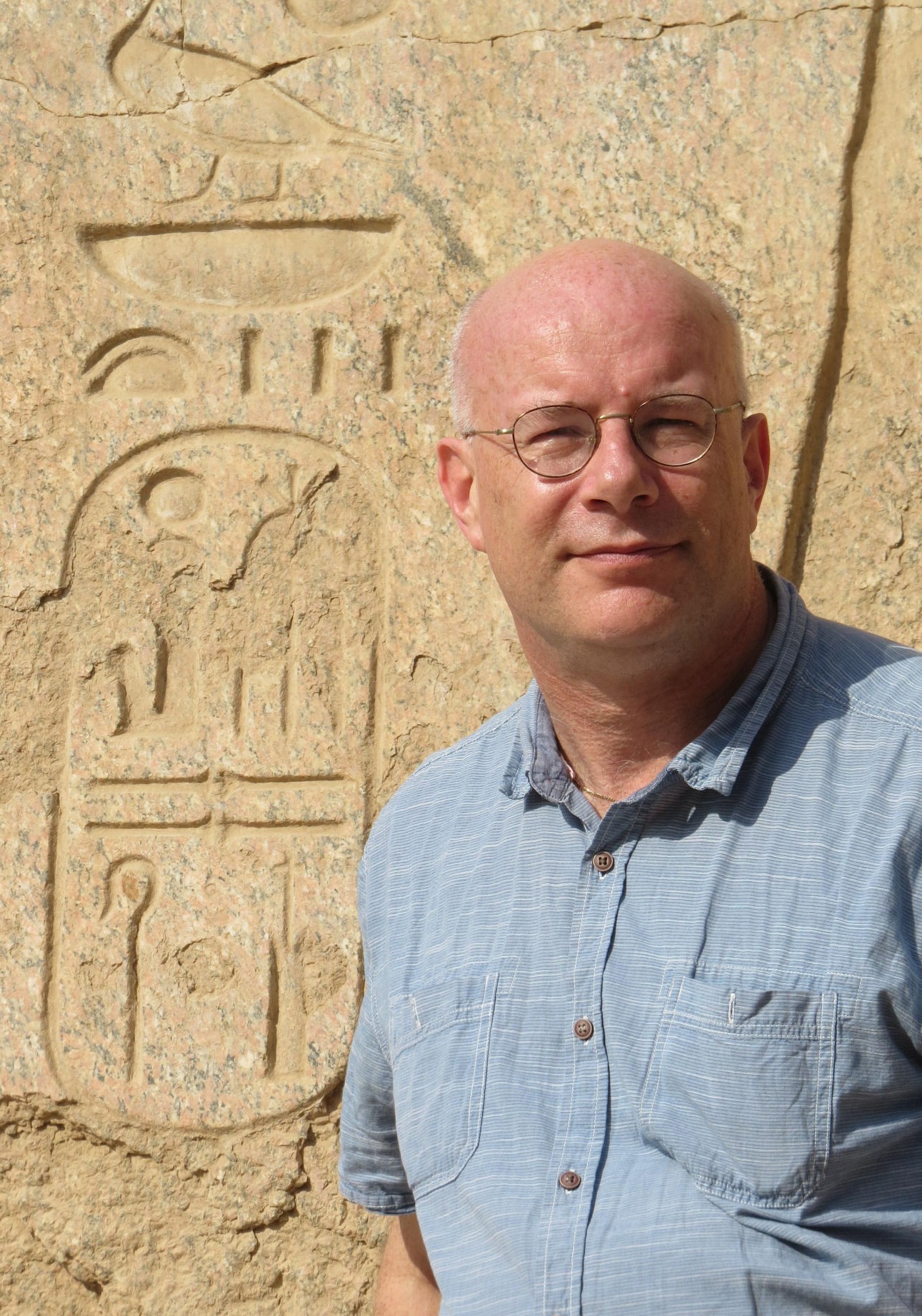
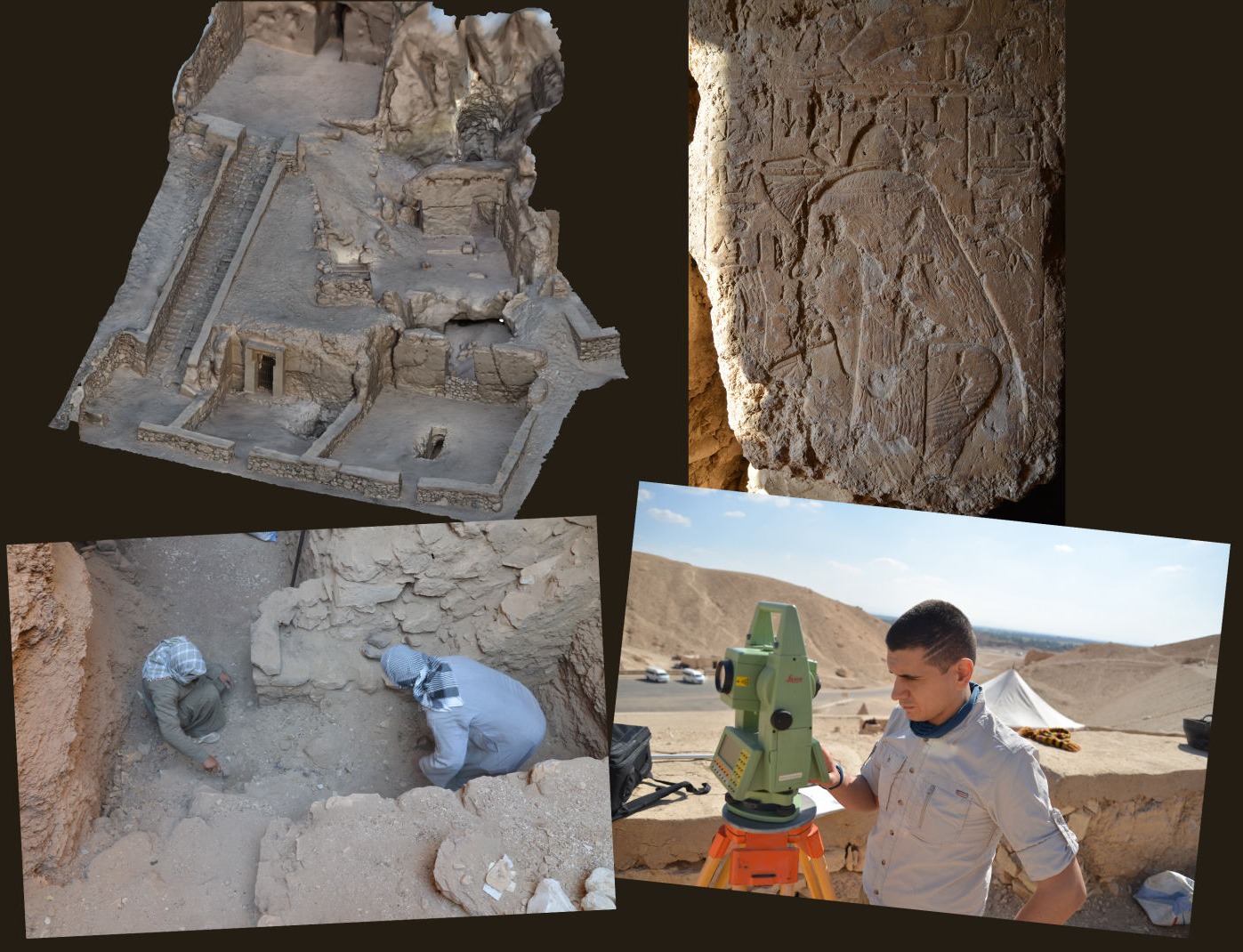
7th June 2021
Cedric gave the society a truly fascinating look at the work that the Museo Egizio has been undertaking at Deir el-Medina. All of the work has been in conjunction with IFAO and the directors of both teams made a joint decision on where to concentrate their efforts. The museum in Turin holds and displays a number of objects from several of the tombs at Deir el-Medina and it was decided to focus on these, with a view to recontextualising the various items in their own tombs. All of the tombs are in the Western necropolis, with TT214 at the southern end and TT8 and TT338 next to each other at the northern end. In future seasons fieldwork will also commence on TT10.
Before any fieldwork was even considered, a thorough research of existing material and records was undertaken, studying all archival documentation from previous excavations – chiefly by Bruyere and Schiaparelli. This helped to assess exactly what was already known about each tomb and put some context back into the museum exhibits. A wealth of material was available in terms of epigraphic records, plans, sections, sketch drawings of decoration in situ and black and white photos.
TT214 was constructed as a tomb for Khawy, Guardian of Deir el-Medina and Servant of Amun, whose wife was Taweret and they had a son named Huy. Subsequently it was reused on numerous occasions right up to the late Roman period with numerous later chambers accessible from the chapel. The museum in Turin holds a lintel and two door jambs and the tomb originally dates to the reign of Rameses II. Bruyere excavated and cleared what was left in this anciently ransacked tomb. Unfortunately it was constructed in the least stable rock in the area and Bruyere’s work destabilised the fragile rock even further, leading to a collapse blocking the tomb completely. When Cedric’s team completed their clearance, they were the first to enter the tomb for a hundred years. During the clearance many small objects were found in the courtyard, though sadly all were out of context. It became clear that Bruyere had used the debris from his own excavations to create a platform for easy access for future visitors and this debris was peppered with small objects. There were also some items left behind by other archaeologists and a 1920s grocery list showed that the excavation team ate very well indeed! After thoroughly surveying and studying, the latest technology was used to create new highly-detailed plans and sections.
TT8 was different in design as the chapel and tomb were not together. Bruyere on discovering the tomb of Kha found that it was still intact. Kha, the Chief of work in the Place of Truth was buried with his wife Merit and they had several children. The complete funerary assemblage was removed to the Museo Egizio, but thanks to meticulous recording at the time most of the objects can be recontextualised as the archival material shows their exact locations in the tomb. New technology has made it possible to use the archived records, pictures, sketches, drawings and photos in order to create a complete picture of how the tomb looked on first being entered by Bruyere. Modern methods have also been used to identify the different components in the colours, which give information of trade routes at the time and provide guidance for conservation work.
TT338 belonged to Maya, Scribe of Outlines, who had many children with his wife Tahit. The existence of this tomb had been known since 1824 when a stela from TT338 was brought to the Museo Egizio. When Schiaparelli rediscovered it he decided to move the chapel decoration to Turin, to be reunited with the stela. The archival material shows that before doing so he documented everything with great care and photos were taken of the decoration in situ. The virtual reconstruction work that has been completed so far at TT338 is to be published in due course.
In addition to the physical work undertaken at the site, the team has used all of the technology available to it to create virtual reconstructions as a record for the future and to make it possible for those who cannot visit in person to experience the inside of these tombs. We wait, with great interest, to hear what the next season’s work brings to light.

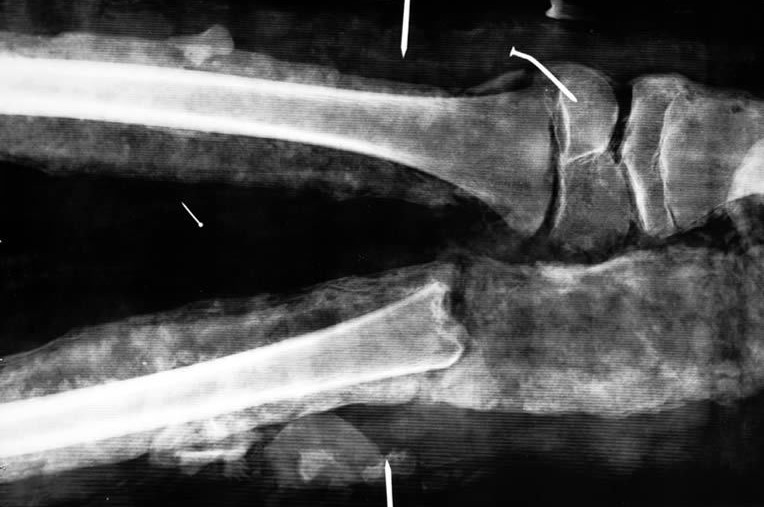
10th May 2021
Lidija first started at Manchester University in 2000 – and never left! Moving from studying to teaching she developed a special interest in the mummies held at the University Museum.
The Museum is currently closed for renovation work and will reopen either next year or, possibly, early in 2023. 18,000 items are held from Egypt and Sudan (including 18 human mummies and 45 animal ones), though typically only about 4,000 objects are out on display. The remainder are held in the on-site stores, where they can be accessed for study and research purposes. Manchester’s story with mummies began in 1908 when Margaret Murray famously unwrapped the Two Brothers and conducted an autopsy of them in front of a large academic audience. As a result unfortunately little now remains of the brothers apart from their skeletons. However, as Petrie recovered them originally with their full tomb assemblage, we have a large amount of information about their lives.
The next chapter in the story was in 1975 when Professor Rosalie David became keeper of Egypt and initiated the Manchester Mummy Project, to study and publish the remains held in the museum. She chose to autopsy a mummy (mummy 1770) that would never be displayed and also collected samples to set up a tissue bank. Xrays were taken (CT scans did not become available until 1979), but most of the information was gained from the autopsy itself which, as in 1908, was very destructive. It was interesting to find that individual had suffered major damage to one leg, which had been reshaped with sticks to give the body an appearance of being whole for the afterlife.
New studies were started in recent years in a far less destructive and more ethical way. A number of human mummies both from Manchester and on loan from other institutions were subjected to multiple digital Xrays and CT Scans, by courtesy of the Children’s Hospital allowing access after hours. The study looked for information about the lives of the individuals, how they had been treated for the afterlife, the mummification process, their age and sex and any pathologies….also whether the coffin and occupant matched, as often this was not the case! Much interesting information was obtained from the studies – outward appearances and what lies beneath are frequently at odds. In particular the ‘Chester Mummy’ (now in the Garstang Museum) is the size of a child and was described in the past as a child’s mummy, but scans now show that all of the body parts inside are feline, carefully arranged into the shape of a small human. Was this perhaps an apprentice piece?
As well as looking at human mummies a selection of various animal mummies were scanned and studied. Almost all of these were found to be a jumbled mess of sticks and stones with, perhaps an odd bone or two, moulded into the shape of the creature depicted. The crocodile did however contain actual crocodile body parts, but turned out to be made up of 4 juvenile skulls placed in a row with 4 hatchlings stretched out above them. Using the latest technology some of the scans have been converted by 3D printing into exact replicas, which can be studied.
The next stage of the project was to try to recreate animal mummies in the lab, based on ancient techniques. The composition of the resin had been analysed and found to consist of 4 parts of resin to 1 part beeswax, plus some aromatic herbs. A sparrowhawk was covered with the preparation then wrapped with strips of linen whilst still sticky. This proved to be quite difficult to do and exceedingly, unpleasantly smelly. It gave an insight into the unattractive working conditions of Ancient Egypt’s embalmers. Although the work was completed with the greatest of care, a subsequent Xray showed that during the process the bird’s neck had been broken, so when ancient mummies are found to have a broken neck it cannot be assumed that this was the cause of death.
A second aspect to the experiments was to test the effectiveness of recognising and identifying different body parts using radiology. Bags of unlabelled mixed bones were supplied by the Natural History museum and the contents of each bag were mummified as a single object, then taken to the hospital to be scanned. Trying to identify the bones from the scanned images proved to be extremely difficult. Subsequently the bones were dried out, unwrapped and thoroughly cleaned and then sent for identification. In these circumstances it was much easier to identify them with a high level of accuracy. Physical bones which had been cleaned of all adhering matter did not present much of a problem, but of course the bones of Ancient Egyptian mummies cannot be treated in this manner. 3D printing from the scans is now being trialled to see if this would give the same ease of recognition – the results are awaited.
Already the new experimental studies have provided a wealth of information about ancient techniques and increased the practical understanding of the mummification process in Egypt.
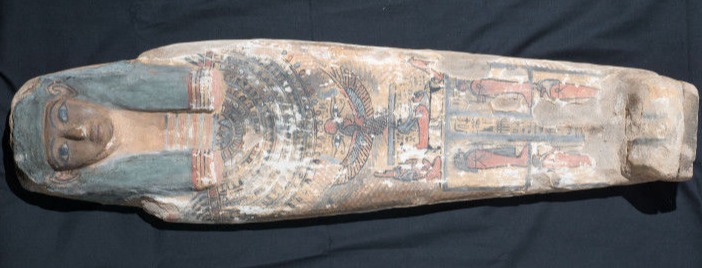
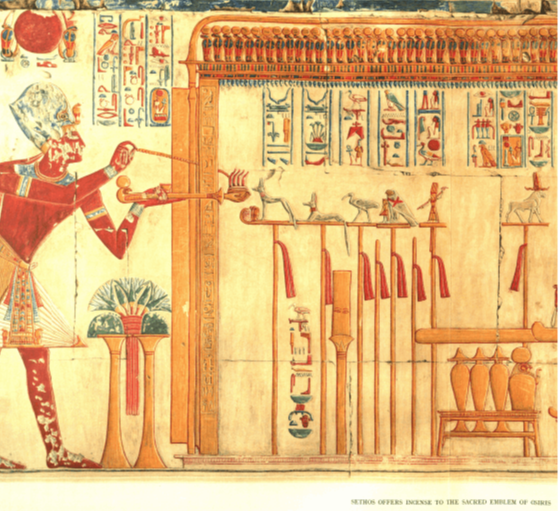
7th April 2021
In the early 20th century the world of Egyptology paid scant regard to the work of artists and epigraphers, often just mentioning them in passing, even though the historical record they produced was of enormous value. Lee Young has a fascination for these people, especially the women, and her research has looked in depth at how they lived in Egypt, the work they achieved and why they chose to go there given the social restrictions of the time.
In this lecture she looked in particular at Amice Calverley and Myrtle Broome, who spent 8 seasons working together on recording the stunning images at the Seti I Temple at Abydos. Amice was born in London in 1896 but whilst she was still young her family moved to Canada. Later she returned to England to pursue her music studies and also spent some time working on archaeological drawings at the Ashmolean, which drew her to Egyptology. The standard of her work and her ability to draw with astounding accuracy were noted by Sir Leonard Woolley, who was directing her work, and she was hired by the EES initially just for a temporary position recording at Abydos. Subsequently, however, she became the director of the Seti I project. Myrtle was also born in London in 1888 to a master craftsman father, who taught her his trade when she grew up and they set up in business together specialising in ornate wood carving and metalwork. Myrtle also studied art and was highly skilled. In 1911 she signed up to classes to complete a Certificate in Egyptology with Petrie as her tutor. At his request she first went out to Egypt in 1927 to record tomb scenes at Qau el Kebir, south of Assiut. The letters she sent home conveyed the immense impression that Egypt made on her and she was enthralled by the landscape and the scenes of everyday life.
Amice was the first of these ladies to start working at Abydos and Myrtle joined her a couple of years later. Myrtle was a prolific letter writer and sent more than 400 letters back to friends and family. She also completed many paintings showing scenes their life there. The letters (now held at the Griffith Institute in Oxford) described all aspects of their lives; their work, living arrangements, interaction with the local village and excursions to see other parts of Egypt. The descriptions, due to her artistic nature, were so evocative that reading her words brings all of her experiences to life in great detail. The ladies differed from their male colleagues in that they wanted to embrace the friendship of the local villagers and explore their way of life, with Myrtle making a great effort to learn Arabic. This made them extremely popular, and Myrtle’s letters provide an excellent social history describing the many traditions and festivals enjoyed there. Over the years the ladies entertained many distinguished guests at the Temple site, including royalty, but Myrtle’s letters make it quite clear that they much preferred the time that they spent with the locals.
Whilst they thoroughly enjoyed this aspect of their lives at Abydos, they were of course there to work and dedicated themselves to this with commitment, determination and outstanding ability. For 6 days a week they donned their work clothes; white coats over jodhpurs and long leather boots (to defend them from snakes!) and worked long hours in trying conditions. Although others joined them over the years few had the stamina and dedication of Amice and Myrtle, who together were responsible for the vast majority of the work which led to the publication of 4 portfolio-sized volumes of the painting and drawings of the Temple. Material for a fifth volume was also provided but, to date, has still not been published. Amice and Myrtle were very modest and humble about their achievements and were quite surprised when their work was received with such acclaim and described, very accurately, as an incalculable contribution to archaeology. Alan Gardiner described Amice as one of the most remarkable women of her time and the same could surely be said of Myrtle.
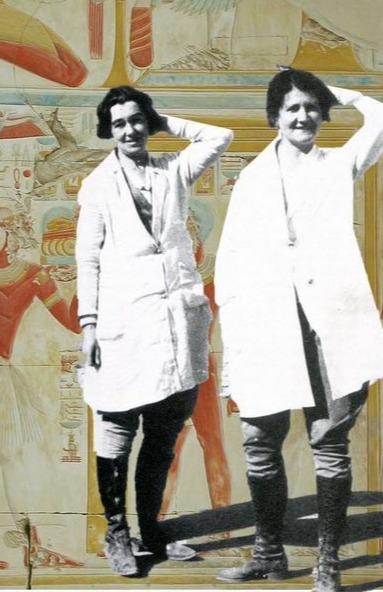
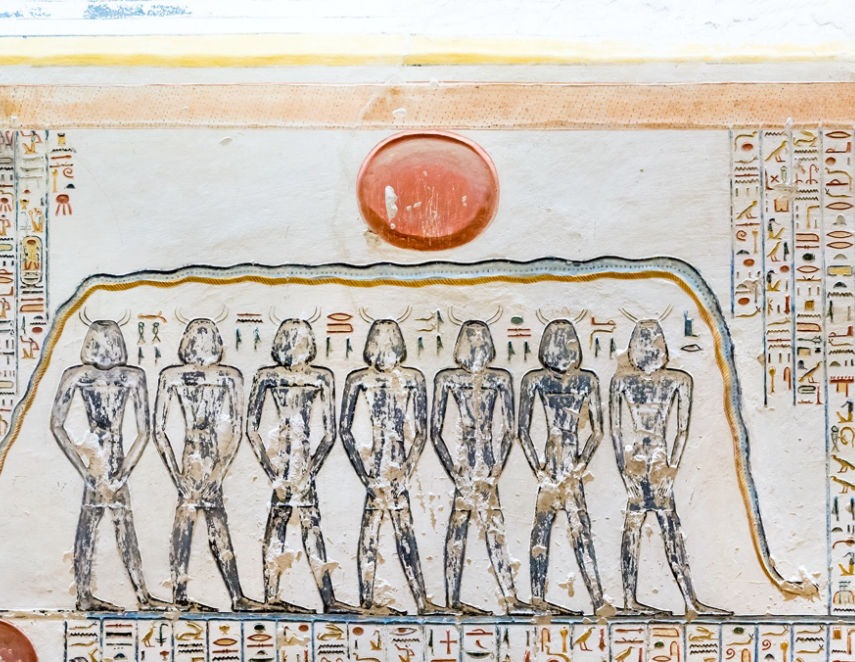
8 March 2021
In this lecture Dawn took us down into the crucial nightly passage through the Book of Caverns. This Book of the Underworld is found in seven of the 19th and 20th Dynasty Rameside tombs in the Valley of the Kings, in the Osireion at Sety I’s temple at Abydos and in one non-royal tomb; TT33, a Late Period Theban tomb. In most of these tombs only a partial version is found.
For a long time it was thought that this Book related to punishment, due to the imagery in the lower registers of cauldrons, in which various punishments are being carried out. However, more recent study and research has determined that these scenes represents punishment for the enemies of Re and Osiris and the overall theme is the same as in the other Books of the Underworld; the nightly Solar/Osirian unity and passing safely through the hours of the night until rebirth at the start of the next day.
Dawn drew our attention in particular to the deities depicted with animal heads, all of which are connected with either Re or Osiris. The first considered was the shrew-headed deity. This is not to be confused with a mouse; the Egyptian shrew is a nocturnal creature living mostly underground, so quite appropriate in this context, and the deity is seen as a bringer of abundant provision. Next came the mongoose-headed deity. The mongoose is infamous for its ability to kill snakes and features as Re in the Book of Caverns in his guise of serpent slayer to defeat Apophis, then going on to join with Osiris. The nightly occurrence of the Solar/Osirian unity is one of the most important scenes in the Book of Caverns. The mongoose was particularly venerated during the Late and Ptolemaic periods.
Dawn then moved on to the catfish-headed deity, which may seem rather unexpected and its presence in the Book of Caverns is unique amongst the Books of the Underworld. However, there have been artistic representations of the catfish since predynastic times and textual references can been found, up until the end of the New Kingdom, in various Old Kingdom tombs, two Middle Kingdom tombs, the Tale of the Two Brothers (NK) and the Ebers Medical Papyrus (NK) where it is claimed that the brain can cure lower leg pain and the skull cures headaches. Unlikely as the catfish may initially seem as a choice for a deity, it does in fact have a number of characteristics, which make it very appropriate. The aspect of fertility is captured in its spawning nature and ability to populate rapidly. In dry periods it can bury itself in mud to await flooding ; a perfect representation of rebirth. The catfish also has the unusual ability to leave receding water and cross land to find another body of water. Anticipation some scepticism, Dawn showed a short clip of a catfish doing exactly this, wriggling along on its fins.
The inclusion of these animal-headed deities in the Book of Caverns shows how they are all connected with re and Osiris and help to achieve the main focus of the Book, which is the fertility of the Solar/Osirian union followed by rebirth.
8th February 2021
Dr Sarah Doherty delivered a lecture to the Society looking at manufacturing techniques in pottery production in Ancient Egypt and the impact of the introduction of the potter’s wheel.
The first attested use of the potter’s wheel is in about 3000BC in the Near East; the area of Iran, Iraq and the Levant. At this time in Egypt vast quantities of pottery were already being created, by hand, with considerable variety in shape, form, use, quality and decoration.
It would appear that the wheel was introduced to Egypt around 2600BC in the reign of Sneferu. It is clear that this new technology was introduced, rather than invented in Egypt. There are a number of prerequisites for successful use of a wheel to be viable, principally the skill to quarry and shape hard stone and the ability to smelt metal to make copper chisels and there is an abundance of archaeological evidence demonstrating that the Egyptians were capable of this long before 2600BC.
The introduction of new technology would normally be expected to bring a range of benefits and with the potter’s wheel we might assume that it would allow mass production, standardisation, a speeding up of the process and greater variety, but in fact this was not the case at all. After the introduction of the wheel there was a noticeable reduction in the decoration and the different techniques; a trait that was also found in the Near East. Mass production of objects such as bread moulds and beer jars continued as before by hand and the wheel only appears to have been used for elite purposes. Examples found are made of basalt, a highly prized stone, which is extremely hard and difficult to work, even though less hard and more common stone would have been equally effective for this purpose. The find spots are also telling, being near temples and cult sites.
It is also evident that, although the pottery was finished on the wheel, it was still started by hand using the commonly used coil method. From 2600Bc onwards many miniature wheel-made pots were placed around pyramid fields and these are the principle finds for wheel created pottery. They were generally about 10cm tall, without decoration, and are presumed to be part of the daily cult offerings. It would seem that, although the potter’s wheel was now available in Egypt, it was reserved for elite use only and the prestige of the vessels being made by means of the new technology was more significant than any aesthetic qualities. Larger vessels were later made using the wheel and at Amarna there are examples of this, but again they were not thrown entirely using the wheel but rather made in stages with the first part by hand, then refinement on the wheel before the next stage was started – again by hand.
Few actual wheels have been found but there are numerous examples in tomb scenes and tomb models and at Beni Hassan there is a particularly fine scene showing the process from start to finish in clear detail. In all instances we see that the wheel was propelled by one hand whilst the shaping was completed by the other, or by both hands when the wheel was still spinning. Sarah constructed a wheel of her own based on this design to see how closely she could replicate the pottery of the Ancient Egyptians, with a good measure of success. It seems, however, that the life of a potter was not one to be envied and the famous satire of the trades describes potters as, amongst other things, muddier than swine and with clothes that are solid!
Sarah’s book based on her PhD research is available from Archaeopress : The Origins and Use of the Potter’s Wheel in Ancient Egypt – Sarah Doherty.
Picture : First known depiction of a potters wheel in Egypt
Tomb of Queen Ty 2450-2300BC Epron & Daumas (1939)
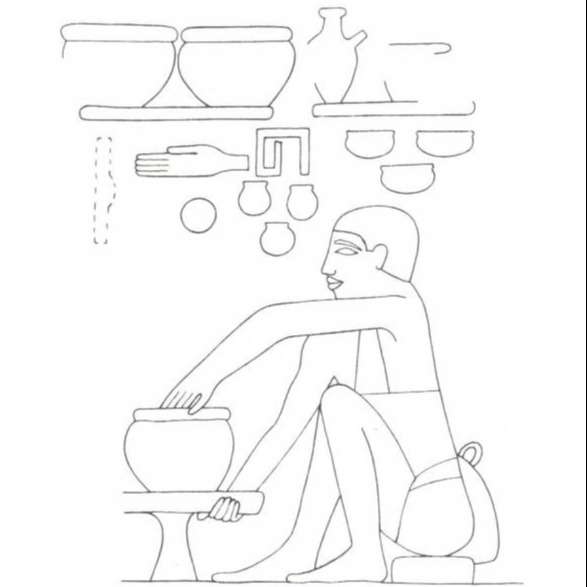
TT8 was different in design as the chapel and tomb were not together. Bruyere on discovering the tomb of Kha found that it was still intact. Kha, the Chief of work in the Place of Truth was buried with his wife Merit and they had several children. The complete funerary assemblage was removed to the Museo Egizio, but thanks to meticulous recording at the time most of the objects can be recontextualised as the archival material shows their exact locations in the tomb. New technology has made it possible to use the archived records, pictures, sketches, drawings and photos in order to create a complete picture of how the tomb looked on first being entered by Bruyere. Modern methods have also been used to identify the different components in the colours, which give information of trade routes at the time and provide guidance for conservation work.
TT338 belonged to Maya, Scribe of Outlines, who had many children with his wife Tahit. The existence of this tomb had been known since 1824 when a stela from TT338 was brought to the Museo Egizio. When Schiaparelli rediscovered it he decided to move the chapel decoration to Turin, to be reunited with the stela. The archival material shows that before doing so he documented everything with great care and photos were taken of the decoration in situ. The virtual reconstruction work that has been completed so far at TT338 is to be published in due course.
In addition to the physical work undertaken at the site, the team has used all of the technology available to it to create virtual reconstructions as a record for the future and to make it possible for those who cannot visit in person to experience the inside of these tombs. We wait, with great interest, to hear what the next season’s work brings to light.

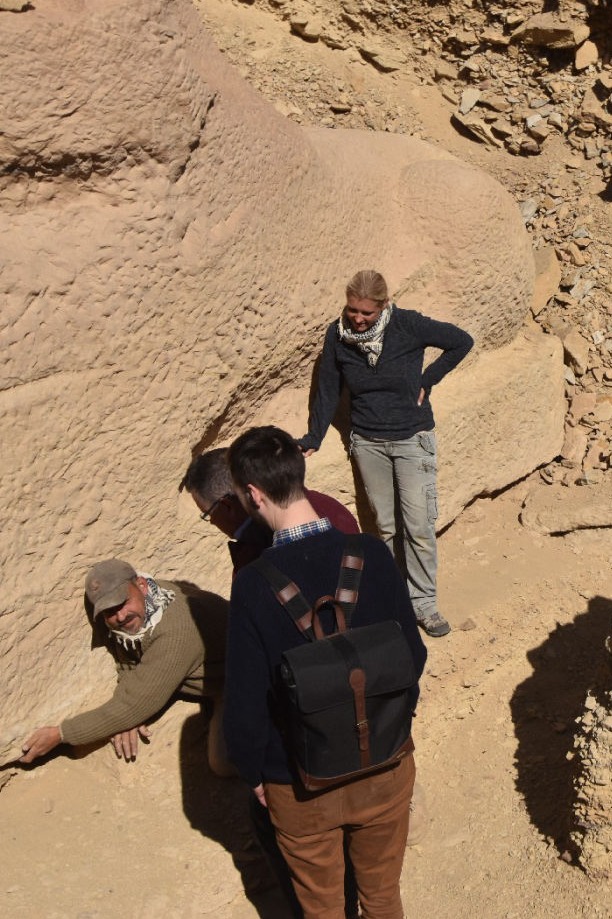
11th January 2021
Dr Maria Nilsson & John Ward
John and Maria joined us via Zoom. Maria was quite familiar with this , but it was John’s first experience. They have been excavating at Gebel el-Silsila since 2012 and introduced us firstly to their hard-working team, with whom they have made a number of remarkable discoveries over the last eight years. Due to Covid-19 restrictions physical presence at the site for the 2020 season was not possible, but instead they took the opportunity to undertake a thorough review of material from earlier years and have published a number of papers.
The site covers an area, on both the West and East banks of the Nile, of 30 square kilometres and, although the majority of their work has concentrated on the New Kingdom, it is clear that, from an Ancient Egyptian perspective, the area was occupied from about 8500 years ago right through to Roman times. Previous scholars have focussed primarily on the quarrying aspect, this being the primary source of Nubian Sandstone used in monumental building projects throughout Ancient Egypt. Maria and John, however, have taken a much broader approach taking into consideration ancient rock art, inscriptions form all periods, settlement activity and infrastructure as well as the 104 quarry sites.
Some of the main areas they have worked on include a worker’s village on the West bank situated on the plateau above the quarry of Tutankhamun. 41 structures have been uncovered in a small town, together with roads, quays and other infrastructure. It seems likely that this was a re-use of an earlier site and, later, the archaeology shows that the area was again used in Roman times.
Moving to the East bank, excavations started in 2015 at the Temple of Sobek. This site was very poorly preserved and had been dismantled in antiquity. Evidence was found from the time of Rameses II and there were also earlier finds from the 18th Dynasty. Interestingly some remains of limestone were found there. It was during the reign of Hatshepsut that the significant shift from building with limestone to sandstone took place. Very close to the Temple another structure was uncovered, which has been called Sobek’s Den. Excavation through many layers has brought to light crocodile remains and further clearance is planned when the team can restart work there.
A little south of the Temple and still on the East bank, a necropolis was discovered but it is in a poor state, due to corrosion by Nile silt from countless inundations reaching the area over the years and current water table issues. So far 73 tombs have been documented; 33 rock cut chambers and 40 crypt burials, including 2 shaft tombs. There are no inscriptions inside any of the tombs, but there are an intriguing number of images of feet. It would appear that the necropolis was used for around 200 years. The primary use seems to have been in the Thutmosid period, though activity ceased before the reigns of Amenhotep III and Amenhotep IV, and there appears to have been some further use in the 19th and finally the 20th Dynasties. From the style of the burials and the funerary objects recovered, it is apparent that this necropolis was not used for the poorest people in the community.
Exciting work has also taken place in an area relating to the time of Amenhotep III and Amenhotep IV and John and Maria will shortly be publishing a paper on this. They very much hope to return to Gebel el-Silsila in 2021 to renew excavations on this area in particular and other parts of the site.